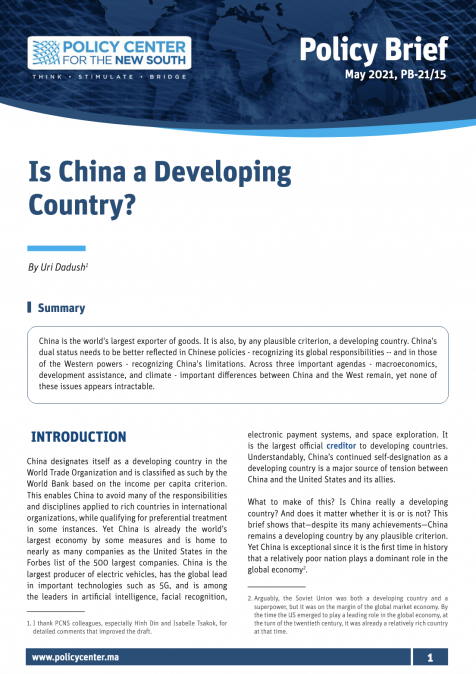Publications /
Opinion
The COVID-19 pandemic caused a shock to both demand and supply, leading to the biggest collapse in world output since the Great Depression. Since late 2020, a more rapid than expected recovery has been observed. Five questions arise frequently. Here is my take on those questions.
1- Is the pandemic receding?
No, but we have a vaccine to control it, and are better at managing it with selective measures, as distinct from total lockdowns, which kill the economy. The global number of new cases remains high as the highly contagious Delta variant spreads, with the epicenter shifting constantly across nations and within them. At the time of writing, the Southern U.S., a very large economy, is one hotspot. We are amid a global third wave, and a fourth wave is likely to follow in the Northern Hemisphere as winter approaches. Across the world, about 10,000 people a day die of COVID-19, compared to about 14,000/day reached in the previous two peaks. Vaccinations are reducing the incidence of severe disease in advanced countries, and vaccines are quickly becoming widely available in the rest of the world. The present global vaccination rate is 38 million per day, which, if maintained, means 75% of the world population will be vaccinated with at least one dose by the end of January 2022. The last great pandemic (1918) faded after three years despite the lack of vaccines. The COVID-19 outbreak is about 18 months old and there may be another 12-18 months to go before it recedes as a major threat. This expectation, or rather, guess, assumes that new variants of the virus will not prove to be more resistant to vaccines than the present ones. Some large African countries, including Ethiopia, DRC, and Cameroon, are still essentially unvaccinated, and they will be the last to see the end of the epidemic.
2- Is the global recovery likely to be sustained?
Most likely, yes, but at a much slower pace than in the first half of 2021. In Q2 2021, 32 of the 40 largest economies grew at a year-over-year rate of 7% or more, with the Eurozone growing at 13.6%, the U.S. at 12.2%, and China at 7.9%. Many developing countries, including Morocco, saw double digit growth in this period. Most recently contemporaneous and leading indicators, from world trade to PMI (Purchasing Managers' Index) have shown a substantial deceleration. The return to work, monetary and fiscal stimulus, and pent-up demand drove growth to unprecedented peaks, but their effects are now abating. Underutilization of labor persists, and as the pandemic continues but becomes more manageable, the global economy is likely to continue to grow at a rate above the long-term trend, say 4%-4.5% over the next year, gradually returning to a sustainable pace near 3% in 2023. If this projection is correct, it will represent a much faster global recovery than that from the Global Financial Crisis of 2008-2009.
3- Is the surge in inflation in the U.S. and Europe likely to be transitory?
Most likely, yes, but headline inflation will remain high over the next twelve months or so. Despite the surge in oil and other commodity prices over the last year (food and industrial commodities up about 20%, with oil prices doubling) and the explosion of freight rates, high inflation is not at this point a global phenomenon. In China and Japan, inflation remains very low, and it is under 2% in several advanced countries. In many developing countries inflation is still quite low, as in Morocco. However, year-over-year consumer price inflation exceeded 5% in the U.S. and was at 3% in the Eurozone in July 2021. There is yet little indication that these high rates are becoming built into expectations, but their continuation over a long period would be bound to lead to increased wage demands, especially – but not only - in highly unionized contexts. The best bet is that inflationary pressures will abate as demand decelerates and the many supply disruptions caused by the pandemic are resolved. Still, inflation is an indicator that bears careful watching because if it forces a sharp tightening in monetary policy, the consequences will be severe across all high-leverage contexts.
4- Is a major correction in global financial markets likely?
Yes, but the macroeconomic impact will probably remain manageable. Over the last two years, since before the pandemic, the S&P 500 is up about 50%, the Eurosoxx50 is up just under 20%, and the MSCI Asia-Pacific is up about 25%. Especially in the U.S., stock prices compared to earnings are extremely high. The yield on less-than-investment-grade (junk) bonds adjusted for inflation is near zero or negative. The present ‘goldilocks’ environment, characterized by zero short-term policy interest rates, rapid growth and still-contained inflation expectations, is the best of all possible worlds for stocks and for investment in risk assets. Those include emerging markets, which have retained access to bond markets, but have been largely absent from the stock market party. Housing prices in many countries are soaring. It is a reasonable bet that sometime over the next year or two, and perhaps sooner rather than later, a correction (20% or more decline) will occur. The correction may be triggered by new virus variants, slowing growth, a shift in inflation expectations, or tightening monetary policy, already under serious consideration in the Eurozone. While the correction will be painful for individual investors, and the most-exposed emerging markets will see a flight from risk assets, it need not turn into a generalized economic downturn. Insofar as the risk is presently borne by those most informed and best positioned to bear it, and insofar as banking systems are well capitalized and adequately hedged—which appear reasonable assumptions—the episode can be contained.
5- Will the pandemic have major long-term repercussions?
Yes, most importantly in the form of higher public debt levels. OECD government borrowing in 2020 amounted to nearly 30% of GDP. In 2021, pandemic-related borrowing is continuing. The U.S. budget deficit is projected at nearly 13% of GDP in 2021; in the Eurozone it is projected at over 7%. This debt—which is presently sustainable given low interest rates—will constrain countercyclical fiscal policy, transfers, and public investment in decades to come. The pandemic has triggered big structural shifts in demand, for example from commercial to residential real estate, and accelerated the shift from brick retailers to on-line, which will take years to play out. At the same time, big productivity and lifestyle improvements from remote work appear far more feasible and likely than was apparent before the pandemic. Finally, the pandemic has increased the income gap between the highly educated who can work remotely, and manual workers, and appears to have shifted income even farther from labor to capital, especially to owners of internet platform businesses and their suppliers. This high and increasing inequality undermines the social contract. In different ways, governments in China, Italy, Morocco, and the United States – to cite examples - are responding by adopting a wide range of progressive and redistributive policies. This, too, may prove to be a legacy of Covid-19.
The opinions expressed in this article belong to the author.




